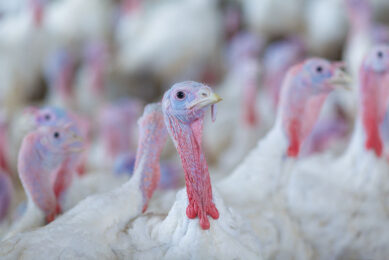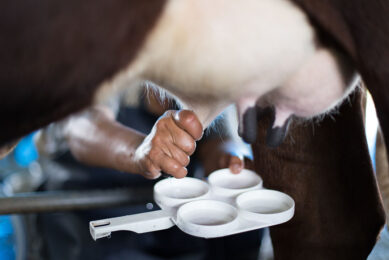Spent mushroom substrate: Degrading DON mycotoxin
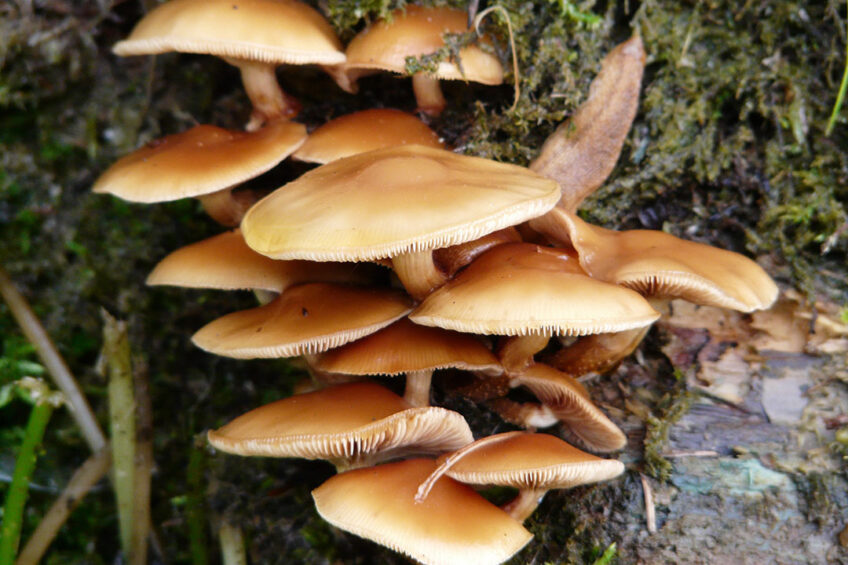
In a recently published study, researchers found the extracts from spent mushroom substrate to inhibit the growth of Fusarium graminearum (the fungi that produce deoxynivalenol (DON) mycotoxin). Their findings describe how the extracts degrades DON in feed and in pig and poultry GIT, in a simulation set-up.
DON is responsible for one of the most severe pollutions in feeds and ingredients. Among other fungi, DON is produced by the fungi Fusarium graminearum, and the grains most affected by this fungi are wheat, barley, oats, and corn – posing a threat to animal and human health.
Spent mushroom substrate is defined as the spent substrate (growing media) and all mushroom residuals resulting from the harvest of mushroom fruit bodies at the growing facilities. Little is known about the degradability of DON by the spent mushroom (Flammulina velutipes) substrate extracts (manganese peroxidase and lignin peroxidase). Flammulina velutipes, also known as velvet shank, is a species of edible mushroom.
Study set-up
The effects of two extracts (manganese peroxidase (MnP) and lignin peroxidase (LiP)) from spent mushroom (Flammulina velutipes) substrate were tested on their ability to inhibition the production of DON and growth of DON-producing fungi F. graminearum
KR1 in an in vitro setup. The degradability of DON in simulated pig and poultry GIT was also determined only for lignin peroxidase extract as it was found, in a pre-test, that LiP treatment has a better antifungal effect than MnP treatment and no significant difference was observed between MnP and LiP treatments on reduction of DON production. For the simulation, different DON concentrations for pig (1 mg/kg) and poultry (5 mg/kg) feeds were used. 180 g of pig and poultry feeds, each with DON concentration of 0.5 mg/kg DON, were premixed with LiP powder (50 U/g) before being mixed with the medium that mimicked the stomach and intestinal conditions (pH and time) for pigs and poultry.
Mycotoxin in animal products
According to the researchers, the passage of mycotoxins or their metabolites into animal products through the contaminated diet is an issue of great importance for the consumers, and the market. “There is a variation in tissue deposition of the mycotoxins among farm animals that is attributed to differences in their absorption and metabolism. In general, the accumulation of mycotoxins and their metabolites in animal muscle tissues is low, often below detection limits due to their intense metabolism in the liver. However, blood, kidney, and liver contain higher levels of mycotoxins and their metabolites than muscles and adipose tissue. As a result, special attention should be given if these offals are consumed,” they say.
Results of the study
Growth inhibition of F. graminearum
The inhibition rate of F. graminearum with LiP treatment was significantly higher than with MnP treatment. The inhibition rates of F. graminearum after MnP and LiP treatments for 7 days were 23.7% and 74.7%, respectively. The microscopic examination revealed that LiP treatment induced marked changes in the fungi’s morphology, leading to significant collapse and breakdown of hyphae (filaments). The fungal cell wall is comprised of glucan and chitin that play essential roles in several biological functions, including maintaining the physical strength of cell walls. In the present study, the chitinase activity were both increased in MnP and LiP treatments compared to that in the control treatment. The growth inhibition observed was attributed to the loss of chitin synthase activity in F. graminearum that, in turn, compromise fungal growth, development, and pathogenicity.
Reduction of DON production
When the F. graminearum culture was treated with both MnP and LiP at 50 U/mL for 7 days, DON production was not detected in either treatments (the limit of detection was 100 µg/kg), whereas the control treatment produced 9 mg/kg of DON. The decrease was attributed to the inhibition capacity of the two peroxidases on growth of F. graminearum which, in turn, minimise DON production.
Figure 1 – Degradability (line) and residual concentration (bar) of DON after LiP treatment in the simulated pig GIT.
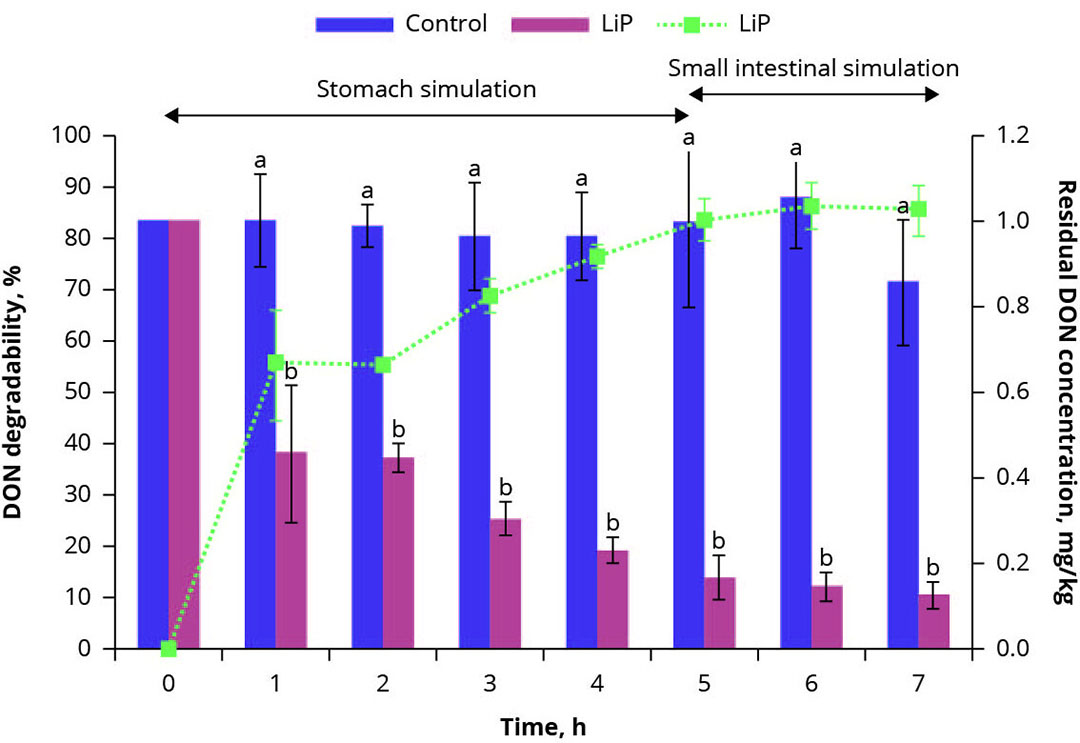
DON degradability in simulated pig and poultry GIT
Because LiP treatment showed a better antifungal effect than MnP treatment and no significant difference was observed between MnP and LiP treatments on reduction of DON production, only the LiP treatment was selected for the pig and poultry GIT simulation trials. For the simulation of pig stomach conditions (pH 2.5) for 5 h, the degradability of DON (at 1 mg/kg) was 83.3%, under the simulated pig small intestine conditions (pH 6.5) the degradability was 85.1%. There was hardly any degradation of DON in control groups (Figure 1). Under the simulated poultry crop and glandular stomach condition (pH 4.5), the degradability of DON (5 mg/kg) after LiP treatment was 39.8%, in the simulated gizzard conditions (pH 2.5), the degradability was 36.5% and under the simulated small intestine condition (pH 6.5), the degradability was 67.2%. These degradability percentages were significantly higher than that in the control groups (Figure 2).
Figure 2 – Degradability (line) and residual concentration (bar) ofDON in the control and LiP treatment groups under poultry GIT
simulations.
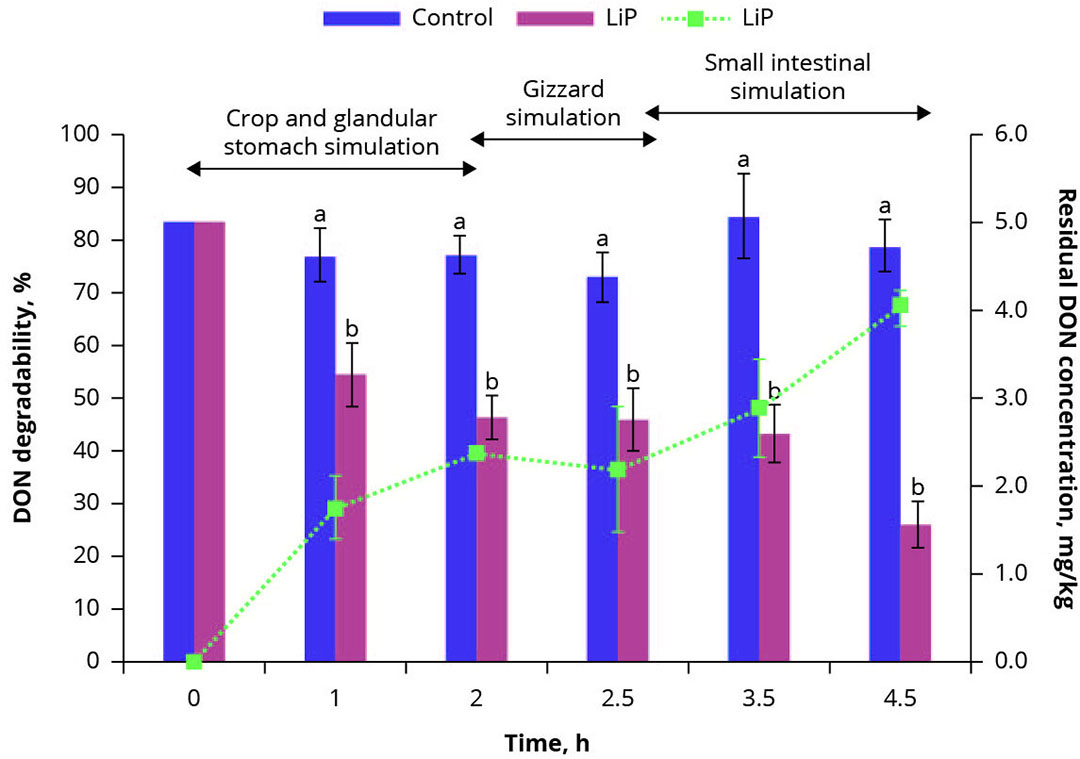
The next step
In addition to the potential applications of manganese peroxidase and lignin peroxidase, the researchers highlighted that their results offer a simplified procedure in turning disposed spent mushroom substrate into a valuable by-product from the mushroom industry in an environment-friendly manner. They stated that it is worth mentioning that MnP and LiP could be developed into antifungal agents and DON-degrading food or feed additives to avoid mycotoxin economic losses. However, they highlighted the need to first establish the toxicity or cytotoxicity levels of both MnP and LiP, as well as their metabolites after enzymatic digestion for the safety of animals and humans. The use of suitable carriers to increase stability of the extracts during storage was emphasised.
Article is based on the research paper The Potential of Peroxidases Extracted from the Spent Mushroom (Flammulina velutipes) Substrate Significantly Degrade Mycotoxin Deoxynivalenol, written by Ko-Hua Tso, Chompunut Lumsangkul, Jyh-Cherng Ju, Yang-Kwang Fan and Hsin-I Chiang. The full paper can be found in the Journal Toxins 2021.





